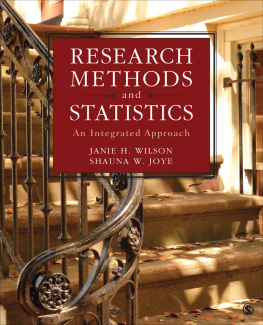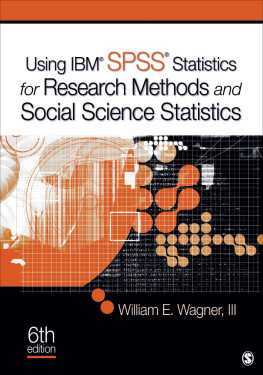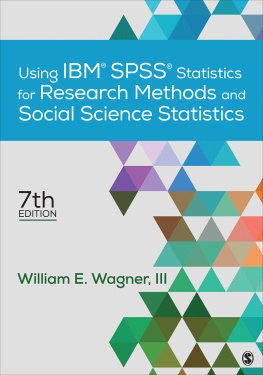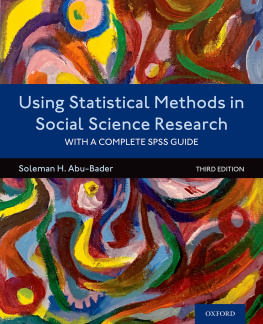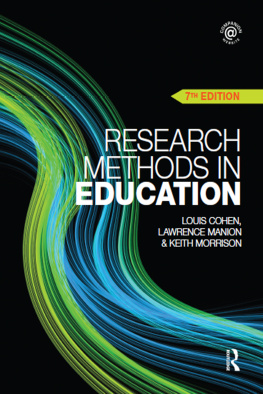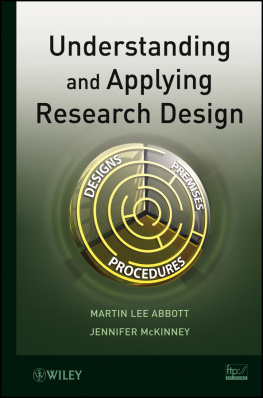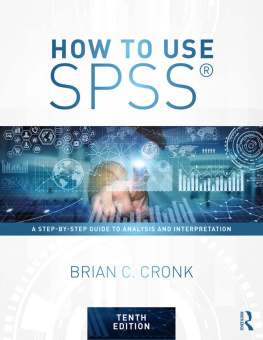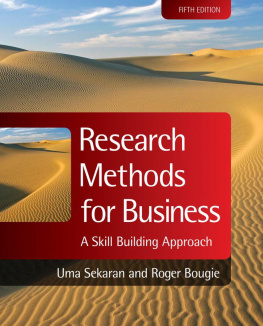Business Research Methods and Statistics Using SPSS
Business Research Methods and Statistics Using SPSS
Robert B. Burns and Richard A. Burns

Robert Burns and Richard Burns 2008
First published 2008
Apart from any fair dealing for the purposes of research or private study, or criticism or review, as permitted under the Copyright, Designs and Patents Act, 1988, this publication may be reproduced, stored or transmitted in any form, or by any means, only with the prior permission in writing of the publishers, or in the case of reprographic reproduction, in accordance with the terms of licences issued by the Copyright Licensing Agency. Enquiries concerning reproduction outside those terms should be sent to the publishers.
SAGE Publications Ltd
1 Olivers Yard
55 City Road
London EC1Y 1SP
SAGE Publications Inc.
2455 Teller Road
Thousand Oaks, California 91320
SAGE Publications India Pvt Ltd
B 1/I 1 Mohan Cooperative Industrial Area
Mathura Road
New Delhi 110 044
SAGE Publications Asia-Pacific Pte Ltd
33 Pekin Street #02-01
Far East Square
Singapore 048763
Library of Congress Control Number: 2008920625
British Library Cataloguing in Publication data
A catalogue record for this book is available from the British Library
ISBN 978-1-4129-4529-5
ISBN 978-1-4129-4530-1 (pbk)
Typeset by Keyword Group Ltd
Printed in Great Britain by TJ International Ltd, Padstow, Cornwall
Printed on paper from sustainable resources
Contents
Preface
This text aims to enable students to:
- understand the importance and application of statistics and research in the business world;
- design effective research studies;
- interpret statistical results;
- use statistical information meaningfully;
- use a statistical package on a computer.
We have set ourselves the daunting task of writing about statistics and research methods for those studying statistics and research methods on business courses at degree and diploma levels. Most students believe they have trouble coping with numbers. So the book is addressed predominantly to non-mathematicians who do not consider themselves to be mathematically minded. These people will constitute part of the next generation of managers and executives, and thus the health of the organizations for whom they will work and carry responsibility will benefit from studying this book.
What business persons need
Our experience as teachers of research methods and statistics has taught us that business people need:
- Reassurance that they are not being blinded by science or bamboozled by the number providers.
- The ability to judge the validity, reliability and true worth of the data provided to them and, if necessary, to be able to challenge the data and the way they have been displayed, summarized and statistically manipulated.
- Sufficient understanding of the basic principles of data collection and processing and some working knowledge of the more important quantitative techniques in common use, including their uses and limitations.
- Enough knowledge to be able to formulate problems and to discriminate between and select the most appropriate techniques for finding the solution to a given problem.
- The confidence to take decisions and to act on the basis of the data provided.
We are all receivers and users of other peoples data. Numbers are all-pervasive in our lives, as business people, as consumers, as voters for political parties and as readers, listeners and viewers of the media. We have to live, work and survive in an increasingly complex world, force-fed on a diet of often incomprehensible, indigestible and, frequently, spurious statistical gobbets from the computer kitchens of government, stock exchanges, banks, market research organizations, and professional and educational institutions. As business people, we are frequently called upon to do something with the figures, to regurgitate them for other peoples use, probably in a different form, write a report, give an oral presentation, and make decisions based on them. We are often required to produce data of our own to submit to others (e.g. tax returns, sales analyses and forecasts, membership statistics, consumer surveys and the like).
With a minimum of mathematical and statistical knowledge, most people can reduce the data to more manageable proportions and make their own valid interpretation. A few simple statistical techniques and test procedures can be applied by most business people to the numbers they are normally presented with; all you need is to know enough about a particular technique or mathematical tool to be able to judge its value and validity in a particular situation and what significance to attach to the figures presented to you. What can be done with the information? Is it actionable? What conclusions can safely be drawn from it? How reliable and valid is it?
You do not need any special aptitudes, mathematical or otherwise, to get to grips with the contents of this book. All you need is (a) the ability to add, subtract, multiply, divide, square and square root, and (b) the willingness to work through the book with an open mind. Being fairly simple fellows, mathematically speaking, the authors are not clever enough to engage in other than the most simple arguments and explanations which they themselves can understand. This should benefit the reader.
The goals of the book
In writing this book, we have tried to achieve several important goals:
| 1 | We wanted a book that really explained statistical concepts and their application in the field of business rather than one focusing on the mathematics and derivation of formulas. What is important is not that the students learn to calculate a correlation coefficient with a large set of numbers, because now computers can do that for them. But what is really important is that students become aware of the underlying logic of the procedure. This text emphasizes the logic behind statistical operations rather than the mathematics. In practice, nearly all the procedures described in the text are inevitably performed by computer, so learning to use them in practice requires learning to perform them by computer and this is provided for in the text. There is comprehensive introduction to data analysis and interpretation using the SPSS (Statistical Package for the Social Sciences) statistical programme with numerous screen shots and 32 SPSS data files for teaching purposes and student activities. |
| 2 | The second goal was to write a book that is rooted in the business world. We carefully chose problems and examples from business situations, covering marketing research, finance, management, transportation, tourism, accounting, public administration, economics, production, advertising, and other areas. |
| 3 | The third goal was to present a wide range of statistical topics and write as complete a book as is possible at an introductory level. We have included several important topics that are not usually included by other authors, such as meta-analysis, the role of effect size and power as alternatives to significance testing, factor analysis, logistic regression, cluster analysis and discriminant analysis. Some of these chapters form extension material on the texts associated website www.sagepub.co.uk/burns |


